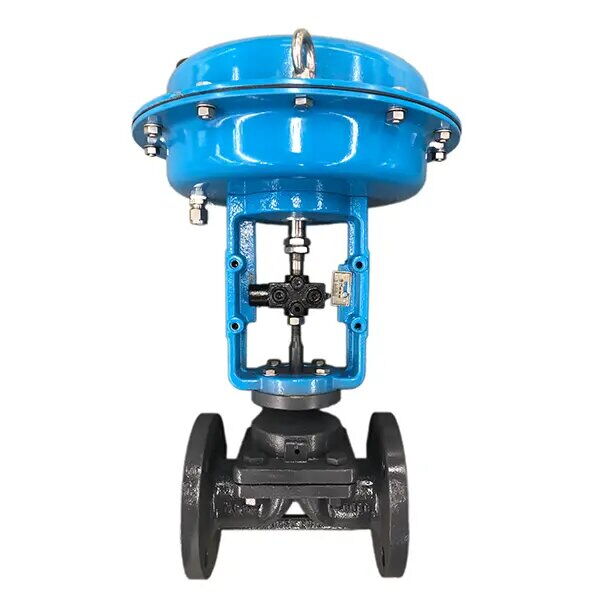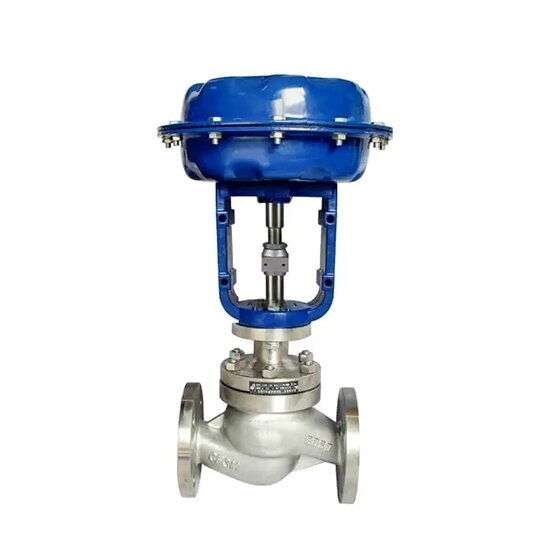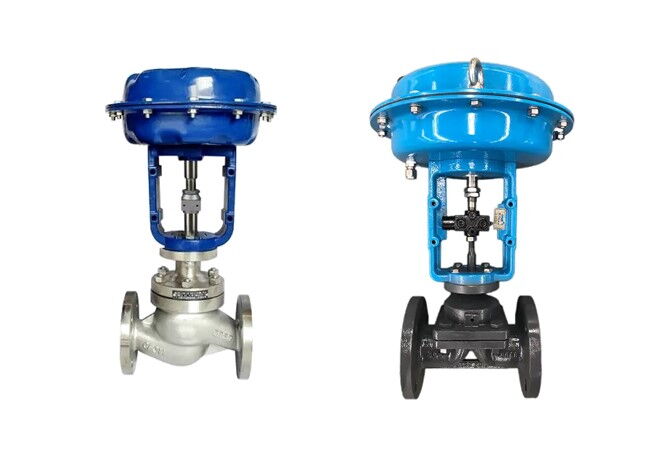Pneumatic Control Valve Comparison: Diaphragm vs. Globe Type
Pneumatic control valves play a critical role in industrial automation, particularly in fluid control systems. These control valves work in conjunction with pneumatic actuators and control systems to enable precise fluid regulation. Among the most common types are pneumatic diaphragm control valves and pneumatic globe control valves, each offering distinct designs and working principles suited for different industrial applications. This article explores the working principles, structural characteristics, applications, advantages, and disadvantages of these two types of pneumatic control valves and provides a comparison to help readers make informed decisions when selecting the appropriate control valve for their needs.
A pneumatic diaphragm control valve is driven by a pneumatic actuator to control the flow and switching of fluids through diaphragm movement. These valves are widely used in fluid control systems, especially for handling corrosive, viscous, and particulate-laden media. The main advantage of pneumatic diaphragm control valves is their excellent sealing capability, which effectively prevents leaks, making them ideal for applications requiring high purity and hygienic conditions.

The basic structure of a pneumatic diaphragm control valve includes the valve body, diaphragm, pneumatic actuator, valve stem, and sealing components. Below is a detailed description of these key components:
Valve Body: The valve body is the external frame of the diaphragm valve, typically made from high-strength, corrosion-resistant materials such as stainless steel or plastic to ensure durability in harsh environments. The valve body connects to the fluid system through piping and supports other components.
Diaphragm: The diaphragm is the core component of the pneumatic diaphragm control valve, usually made from elastic materials such as rubber, PTFE (Polytetrafluoroethylene), or metal composites. It provides an excellent seal and is designed to control the flow of fluid by moving in response to actuator forces. The diaphragm interacts closely with the valve body to prevent fluid leakage.
Pneumatic Actuator: The pneumatic actuator provides the power for the diaphragm valve, using compressed air to drive a piston or diaphragm to operate the valve. Actuators are typically either single-acting or double-acting, depending on the required operational conditions.
Valve Seat and Plug: The contact and separation of the valve seat and plug determine whether the fluid flows. The movement of the diaphragm controls this interaction, ensuring precise flow regulation.
During operation, the pneumatic actuator receives control signals, and air flows through the actuator's air chamber, driving the piston or diaphragm. When the diaphragm rises, the valve plug separates from the seat, allowing fluid to flow. Conversely, when the diaphragm lowers, the valve plug seals the seat, stopping the fluid.
Pneumatic diaphragm control valves offer several key advantages that make them indispensable in various industries.
Excellent Sealing: The diaphragm seals tightly against the valve seat, preventing fluid leakage, especially in high-sealing applications. Since there are no mechanical seals, the risk of leaks typically associated with mechanical sealing is eliminated.
Corrosion Resistance: The materials used in the valve body and diaphragm provide excellent resistance to chemical corrosion and physical wear, making them suitable for use in harsh chemical, oil, food, and pharmaceutical industries.
Simple Design and Easy Maintenance: Pneumatic diaphragm control valves are designed with simplicity and compactness, requiring minimal maintenance. The valve body and diaphragm are easy to disassemble and replace, reducing downtime and maintenance efforts.
Adaptability: These valves are ideal for handling fluids with particles, sediments, and impurities, effectively preventing these from affecting valve performance.
Minimal Temperature Sensitivity: Diaphragm valves perform well in extreme temperature conditions, providing stable operation even in high or low temperatures.
Despite their many advantages, pneumatic diaphragm control valves do have some limitations, such as their relatively higher cost and limited ability to handle very high-pressure systems compared to other valve types.
Pneumatic diaphragm control valves are widely used in industries that require high sanitary standards and precise control, such as:
Pharmaceutical Industry: Pneumatic diaphragm control valves are used to regulate the flow of high-purity liquids and gases, particularly in sterile production environments where hygiene and sealing are crucial to avoid cross-contamination and ensure product quality.
Food and Beverage Industry: These valves are used for precise liquid control during food and beverage production, ensuring fluid purity and compliance with hygiene standards.
Chemical Industry: Pneumatic diaphragm control valves handle a wide range of chemical liquids, including corrosive, highly acidic, or viscous substances, ensuring reliable flow control in challenging environments.
Semiconductor Industry: The production of semiconductors requires ultra-pure chemicals and water, and pneumatic diaphragm control valves ensure contamination-free fluid flow and precise control.
Other industries, including water treatment, mining, energy, and environmental protection, also benefit from the versatility of pneumatic diaphragm control valves, especially when handling fluids with solid particles or corrosive properties.
Pneumatic globe control valves are used for regulating fluid flow and switching in pipelines. Unlike pneumatic diaphragm control valves, pneumatic globe control valves are designed primarily for flow control and on/off operations. They use a pneumatic actuator to move the valve plug, regulating or shutting off the fluid flow.

The basic structure of a pneumatic globe control valve includes the valve body, valve plug, pneumatic actuator, valve seat, and other components. While the working principle is similar to that of the pneumatic diaphragm control valve, the key difference lies in how they regulate fluid flow. Here's a detailed look at the key components:
Valve Body: The valve body is made from materials such as cast steel, stainless steel, or alloys that can withstand high temperatures and pressures. It connects to the piping system to handle fluid pressures.
Valve Plug and Valve Seat: The valve plug interacts with the valve seat to control fluid flow. The pneumatic actuator moves the plug up and down, controlling the fluid's passage or stopping it completely.
Pneumatic Actuator: The actuator drives the valve plug's motion using compressed air, allowing for either single-acting or double-acting control, depending on the specific requirements of the application.
When the pneumatic actuator receives control signals, it uses compressed air to move the piston or diaphragm, which in turn moves the valve plug. When the plug makes contact with the seat, it cuts off the flow; when the plug separates from the seat, flow is allowed.
Pneumatic globe control valves offer several benefits, including:
Precise Flow Control: They provide excellent flow regulation by controlling the valve plug's position, making them ideal for applications that require precise fluid flow control.
Quick Response: Pneumatic globe control valves respond quickly to control signals, making them suitable for operations that require fast opening or closing, such as emergency shutdowns or flow adjustments.
High Sealing Performance: These valves feature a good sealing ability, which helps prevent leaks and ensures the system's stability and safety.
Strong Adaptability: Pneumatic globe control valves are suitable for handling a variety of media, especially high-temperature, high-pressure, or corrosive substances.
Long Service Life: The use of durable materials and precise manufacturing ensures long operational lifetimes, even in high-frequency use scenarios.
Pneumatic globe control valves can be more expensive to maintain and require regular checks to ensure optimal performance, especially when handling highly abrasive or corrosive fluids.
Pneumatic globe control valves are commonly used in industries where precise flow control and rapid on/off operations are required:
Oil and Gas Industry: These valves are widely used for pipeline flow control during oil and gas transmission to ensure smooth fluid delivery.
Chemical Industry: In chemical processes, pneumatic globe control valves regulate the flow of high-temperature, high-pressure, or corrosive fluids.
Power Industry: In power plants, these valves are used for flow control in boilers, steam pipelines, and heat exchangers, ensuring stable system operation.
Water Treatment Industry: Pneumatic globe control valves are used to control water flow in treatment plants, ensuring stable flow rates during processing.
When choosing between pneumatic diaphragm control valves and pneumatic globe control valves, the decision should be based on the specific application, fluid type, and control requirements. Below is a detailed comparison.
|
Feature |
Pneumatic Diaphragm Control Valve |
Pneumatic Globe Control Valve |
|
Suitable Media |
Corrosive, viscous, particulate-laden fluids |
Common liquids, gases, steam |
|
Sealing Performance |
Excellent, ideal for high-seal applications |
Good, suitable for standard fluid control |
|
Response Speed |
Moderate |
Fast |
|
Industries |
Chemical, food, pharmaceutical, semiconductor |
Oil & gas, chemical, power, water treatment |
|
Maintenance & Cleaning |
Easy disassembly and cleaning |
Requires regular maintenance and inspection |
|
Cost |
Relatively higher |
More economical |
Pneumatic diaphragm control valves and pneumatic globe control valves each have unique advantages and application areas in industrial fluid control systems. Pneumatic diaphragm control valves, known for their excellent sealing performance and corrosion resistance, are especially suitable for applications that require high hygiene and sealing standards. On the other hand, pneumatic globe control valves, with their precise flow control capabilities and quick response features, are widely used in industrial environments that require efficient and rapid opening and closing. Choosing the right control valve type not only enhances the system's operational efficiency but also ensures its long-term safety and stability. Ultimately, the correct control valve selection should be based on a comprehensive evaluation of the specific working conditions, medium characteristics, and flow regulation requirements, thus maximizing the performance and reliability of the fluid control system.

